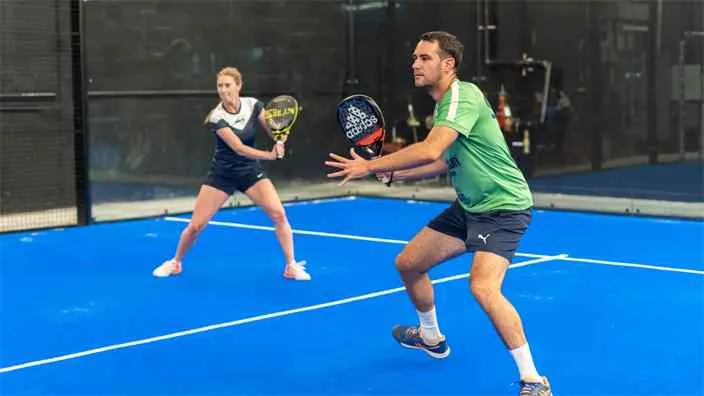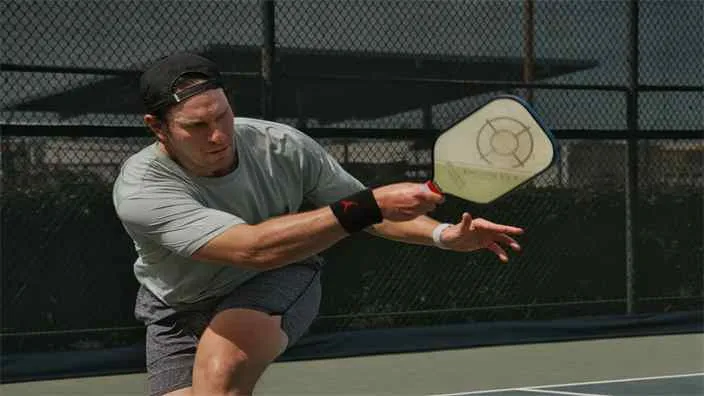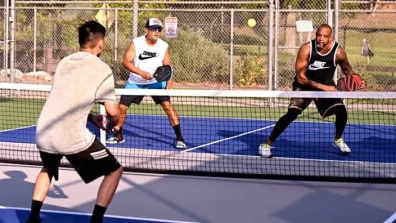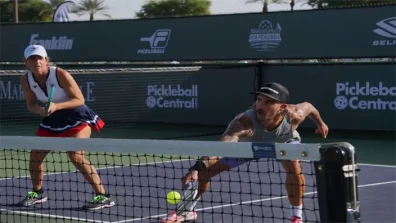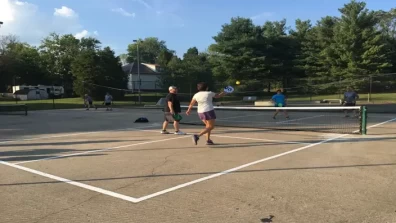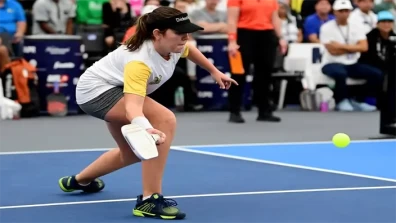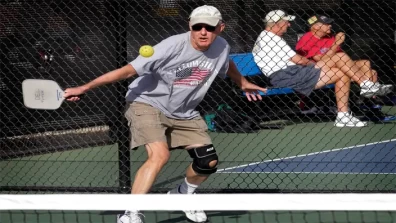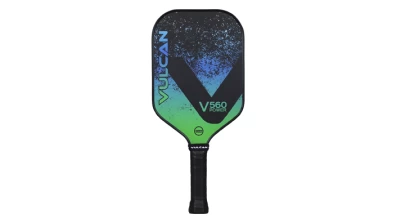Are you feeling a bit perplexed about what is the difference between pickleball & paddleball? And what about padel and racquetball? Aren’t all these sports somewhat similar? So what’s the fuss? But these racket sports may seem surprisingly identical at first glance, yet each brings its unique flair to the court.
From their origins to equipment, court dimensions, and gameplay, there are striking distinctions that set them apart. In this article, we’ll unravel the major differences between pickleball, paddleball, padel, and racquetball. So, let’s figure out which sport suits your style best!
Table of Contents
Pickleball Vs. Paddleball: Key Differences
Pickleball and paddleball, though similar racket games have notable differences. The significant contrast comes in how you score, serve, and the type of paddles used. There are variations in court size and net presence, too. But what is the paddle ball and pickleball game? Paddleball is a sport that evolved from an American handball that uses a light ball in a handball court with four walls. The players use their bare or gloved hands to play this game.
But the short-handled perforated paddle in paddleball was created because the ball’s force and hardness made playing painful in the cold northeastern US weather. On the other hand, in 1965, pickleball began as a fun game for kids on Bainbridge Island in Washington state. It has a combination of tennis and ping pong rules where either two or four players use paddles to hit a hollow plastic ball over a 34-inch-high net.
In paddleball, the aim is to paddle the ball, making it bounce off the wall and back into the court. You can play it singles or doubles, and the fundamental rule is that the ball can’t touch the court floor more than once in a rally to be valid. Scoring happens when the serving team gets a point. The goal is to score points by making it tough for the other side to return the ball or catch them breaking the rules. But what is the difference between pickleball and paddleball regarding court dimensions?
1- Pickleball Vs. Paddle Tennis Court Dimensions
Pickleball courts officially measure 20 by 44 feet. When it comes to outdoor courts, they’re often made from asphalt or concrete. On the other hand, indoor pickleball courts are usually constructed using materials like wood, plastic, or rubber. There’s also a 7-foot “kitchen” or non-volley zone on both sides of the court.
On the flip side, paddleball or paddle tennis courts are a tad bigger. They’re 20 feet wide but longer at 50 feet instead of 44 of the pickleball court and without a net. The lines on the court are also set up differently, and you won’t find the non-volley zone on a paddle tennis court. There’s also a difference in pickleball vs. paddleball racket.
2- Pickleball Paddle Vs. Paddleball Paddle
In Pickleball, the paddles are way smaller and smooth. They can be made of wood, graphite, or composite materials. On the flip side, paddleball paddles are larger and have a textured surface.
3- Pickleball Scoring Vs. Paddleball Scoring
In paddle tennis, both teams can score following the regular rules. But with pickleball, only the serving side can earn points. They keep scoring until they make a mistake, then the other team gets their chance, and the points are gained one by one, and only the serving team can rack them up. The serving side keeps scoring until they slip up, and then it’s the opponent’s turn.
Usually, pickleball games go up to 11 points, and a team must reach this threshold with a 2-point lead to win. Whereas in paddle tennis, scoring is akin to traditional tennis, starting at love and progressing by 15, 30, and 40 before someone wins a game. After a valid serve, the receiver has to hit the ball before it bounces twice on the court.
The game continues with players taking turns to hit the ball, aiming to avoid double bounces or going out of bounds to keep the point. The tournament ends when one team reaches the required points, usually 15, 21, or 25. You also need a 2-point lead to win. If it’s tied, the game continues until one team edges ahead by two points. Pickleball and paddle tennis also share similar serving rules, but some subtle differences exist.
4- Pickleball Serving Vs. Paddleball Serving
Pickleball doesn’t allow bouncing the ball before serving. Instead, it must be dropped and served underhand. The ball is served diagonally, and the service position switches from left to right after each point. But paddle tennis has a height limit of 31 inches for serving. The players can drop or bounce the ball before serving as long as it’s an underhand serve.
However, both sports give each player only one chance to serve. In addition, regarding pickleball vs. paddleball popularity, pickleball has become a real hit, especially in the US, with almost 5 million players. It’s also catching on worldwide. Paddleball, on the other hand, is fun but not as popular as Pickleball. And just to clear any confusion, it’s important to mention that paddleball and padel are two distinct sports. So, don’t mix them up.
Paddle Tennis Vs. Padel: What's The Difference?
Paddle tennis is similar to mini tennis and can be played in singles, unlike Padel, which is exclusively doubles. Moreover, padel combines tennis, squash, and Basque pelota elements, making it an exciting game with quick moves, direction changes, and sharp reflexes. Besides, the court setup is the major contrast between padel and paddle tennis. Padel courts have glass walls and fences, whereas paddle tennis courts do not. But how padel is different from pickleball?
Pickleball Vs. Padel: Battle Of The Rackets
Here are the significant differences between both games:
- Origins & Court Design - Pickleball traces its roots back to badminton, whereas Padel originates from tennis. Moreover, padel courts are enclosed with glass and fences, allowing the ball to bounce off the walls. In contrast, Pickleball is played on open courts with no wall rebound.
- Gameplay & Equipment - Padel primarily involves doubles play, with only a few singles courts available. In Pickleball, you have the flexibility to play either singles or doubles on the same court. Regarding the difference in equipment for both games, padel rackets have a thicker, perforated surface, while pickleball paddles feature a solid and smooth surface. The ball used in padel is similar to tennis but with lower pressure for lower bounces, while pickleball uses a plastic ball with perforations that moves slower through the air.
- Popularity - When it comes to pickleball vs. padel popularity, pickleball holds the popularity crown in the US. It ranks as the second most-played outdoor racket sport after tennis and steadily gains more fans yearly. On the global stage, padel takes the lead, especially in about 3 or 4 Latin countries, including Spain, Latin America, and Europe.
But it hasn’t reached the same level of popularity in the US as pickleball. Now that we’ve explored the popularity differences between pickleball and padel let’s find out the distinctions between paddleball and racquetball, another popular racket sport.
You Might Be Interested: Can You Play Pickleball On A Tennis Court?
Paddleball Vs. Racquetball: The Showdown
These games are quite alike, played on similarly-sized courts, and share mostly similar rules. They both have their tennis-based origins, with slight differences in how they're played and scored. Here are the key differences between both games:
- Equipment & Gameplay- In paddleball, a solid paddle with a textured surface is used, along with an unpressurized black ball featuring a small hole. This game can go up to 21 points and is generally slower-paced with frequent player contact. While racquetball is a high-intensity game, offering a quick calorie burn in a match lasting around 20 minutes, it is suitable for both indoor and outdoor play. It involves a strung racquet and a hollow rubber ball for effective wall bouncing.
- Court Layout & No. Of Players - Racquetball courts measure the same as paddleball courts, except three walls enclose them. Paddleball can be played with two, three, or four players. Whereas racquetball games involve either two or four players.
Frequently Asked Questions
What Is The Difference Between Padel & Pickle?
Padel and Pickle might seem similar, but they have distinct origins. Pickleball came from badminton, while Padel evolved from tennis. This leads to differences in court dimensions, rules, and scoring. In Padel, players can hit the ball after it bounces off the glass walls, but in Pickleball, you play on an open court with no wall rebounds. The equipment used is also different.
Which Sport Is Most Similar To Pickleball?
Sports akin to Pickleball include tennis, badminton, paddleball, padel, squash, racquetball, beach Tennis, and table tennis. They all involve using a racket or paddle to rally a ball or shuttlecock over a net.
Are Pickleball & Paddleball The Same Sport?
Pickleball & Paddleball are not the same sport. They share some similarities in equipment but are played differently on distinct court types. Moreover, there’s also a difference between their scoring and serving rules.
Is Pickleball An Indian Sport?
Pickleball didn’t originate in India. It was invented in the United States in 1965. However, it has gained popularity in India during the COVID-19 pandemic due to its non-contact nature and health benefits. The first attempts to introduce the game in India started in the late 2000s.
Is Paddleball An Olympic Sport?
No, paddleball isn’t part of the Olympic lineup. Paddleball is a well-liked game, often played on more compact courts than tennis, with players using paddle racquets. It offers both singles and doubles play options but hasn’t secured a place on the Olympic sports list.
Conclusion
In the matchup of pickleball vs. paddleball, it’s evident that each game has its own charm. Pickleball has found its stronghold in the US, while paddleball boasts a fanbase in Latin America and Europe. The distinctions in court design, equipment, and gameplay create two entirely unique experiences. And let’s not forget padel and racquetball, which also add their own flavors to the world of racket sports. Ultimately, the choice between these sports depends on your preferences and the kind of excitement you seek on the court. So, which side of the net will you choose?

